IRS Releases Form and More Guidance on Small Business Health Care Tax Credit
DECEMBER 2, 2010
On Thursday, the IRS released a new form and guidance relating to the small business health care tax credit for the 2010 tax year. The guidance (Notice 2010-82) discusses issues relating to employers’ eligibility for the credit and other eligibility issues.
The Patient Protection and Affordable Care Act, PL 111-148, enacted IRC § 45R to provide tax credits for small businesses, beginning in years after 2009, designed to increase levels of health insurance coverage. In 2010, small businesses—defined as businesses with 25 or fewer employees and average annual wages of less than $50,000—are eligible for credits of up to 35% of nonelective contributions the businesses make on behalf of their employees for insurance premiums. Tax-exempt organizations get a 25% credit against payroll taxes. (For years after 2013, the amounts of the credit are 50%, and 35% for exempt organizations.) The amount of the credit is based on a percentage of the lesser of: (1) the amount of nonelective contributions paid by the eligible small employer on behalf of employees under the arrangement during the tax year, and (2) the amount of nonelective contributions the employer would have paid under the arrangement if each such employee were enrolled in a plan that had a premium equal to the average premium for the small group market in the state (or in an area in the state) in which the employer is offering health insurance coverage.
New Form 8941, Credit for Small Employer Health Insurance Premiums, is a one-page form to be used in calculating the amount of the credit, which is then reported on Form 3800, General Business Credit, line 29h, or Form 990-T, Exempt Organization Business Income Tax Return, line 44f (in the case of tax-exempt employers). The Form 8941 instructions include worksheets and the state-by-state average premiums for small group markets to be used in figuring the reduction of the credit when the premiums paid by the employer exceed the amount of the small group market average premium.
The notice says that employers that are exempt from tax under IRC § 501(a), but not described in section 501(c), are not eligible for the credit. However, a section 521 farmers’ cooperative that is subject to tax under section 1381 is eligible for the credit as a taxable employer (as long as it meets the other eligibility requirements).
The notice clarifies that section 45R does not require the employees to be performing services in a trade or business in order for the employer to claim the credit. Therefore, if an employer otherwise meets the eligibility requirements, the fact that the employees are not performing services in a trade or business (for example, household employees) will not disqualify the employer.
The notice states that eligible small employers located outside the United States that have income effectively connected with the conduct of a trade or business in the United States may claim the credit only if the employer pays premiums for health insurance coverage issued in and regulated by one of the 50 states or D.C.
Under section 45R, sole proprietors, partners in a partnership, shareholders owning more than 2% of the stock in an S corporation, and any owners of more than 5% of other businesses—and their family members—are not taken into account as employees for purposes of the credit. However, the section 45R definition of “family member” does not specifically refer to spouses. The IRS says, however, that certain spouses are nevertheless excluded from the definition of employee. Specifically excluded are:
(1) The employee-spouse of a shareholder owning more than 2% of the stock of an S corporation;
(2) The employee-spouse of an owner of more than 5% of a business;
(3) The employee-spouse of a partner owning more than a 5% interest in a partnership; and
(4) The employee-spouse of a sole proprietor.
The IRS bases this on other ownership attribution rules in the Code (IRC §§ 1372(b), 318, 416(i)(1)(B)(i)).
The notice says that leased employees are counted in computing a small business’s full-time equivalent employees for purposes of the credit; however, the business cannot take into account premiums paid on behalf of that leased employee by the leasing organization.
The notice also clarifies that health savings accounts (HSAs) and self-insured plans, including health reimbursement arrangements (HRAs) and flexible spending arrangements (FSAs), are not “qualifying arrangements” for purposes of the credit because they are not health insurance coverage. The notice also discusses multiemployer health and welfare plans and church welfare benefit plans, which can count as qualifying arrangements for the credit.


